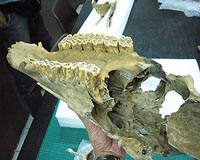| . |  |
. |
Stony Brook NY (SPX) Dec 15, 2009 A newly discovered dinosaur that lived approximately 215 million years ago (Triassic Period) in the region of New Mexico in the United States is providing a team of paleontologists new information on early dinosaur evolution. Reported in Science, an analysis of Tawa hallae, a meat-eating theropod dinosaur between two-and-four meters long, reveals that the early history of theropods was characterized by waves of migration from South America, not just localized or regional species diversification. "To understand how these early theropods were related evolutionarily, we analyzed hundreds of morphological features then used recently devised statistical methods to model how the distributions of these dinosaurs evolved during the Triassic," says Alan H. Turner, Ph.D., Assistant Professor of Anatomical Sciences at Stony Brook University and a co-author of the study. Originally excavated in 2006 at Ghost Ranch in northern New Mexico, two nearly complete skeletons and several other partial specimens of Tawa hallae provided the scientists with the samples they needed to complete a full anatomical analysis and model its evolutionary history. This anatomical information gathered from Tawa helped fit all Triassic theropod dinosaurs into the evolutionary tree of the group. At Ghost Ranch, Dr. Turner and colleagues observed three distantly related carnivores in the Late Triassic beds, which implied that each carnivore descended from a separate lineage before arriving in North America, instead of all three evolving from one local ancestor. The skeletons of Tawa found in that area display characteristics that exist in the two others excavated at Ghost Ranch, fossils from a carnivore closely related to Herrerasaurus, which lived in South America, and Coelophysis, common to North America. Yet, Tawa also had features of neither, which indicates a separate lineage. Tawa is an example of a fossil that fills a morphological gap, which arises when a fossil record is incomplete. The researchers point out that the fossil is not a missing link on the dinosaur evolutionary chain, as it evolved on its own lineage. In addition, because Tawa was well preserved and a complete skeleton, the team was able to answer a lot of questions that normally surface when examining fossil lineage. "One of the biggest morphological gaps in early dinosaurs lies between Herrerasaurus and animals that are clearly more related to birds, such as Coelophysis or Dilophosaurus," explains Sterling Nesbitt of the University of Texas at Austin, the lead author of the study. "Tawa fits perfectly in between, morphologically. It retains characteristics that existed in Herrerasaurus that we thought were more primitive while also possessing features seen in unmistakable theropods (including birds), such as the presense of air sacs surrounding the braincase and neck." Dr. Turner, an expert on theropod dinosaur evolution and biogeography, the study of how and where organisms distribute around the world, explains that in the Triassic when Tawa and animals like them were evolving all the continents were united in a single landmass called Pangaea. However, by the Late Triassic North America was becoming isolated from present day continents (i.e., South America, Europe). Isolation is an important aspect of the speciation process, and thus evolution. "Based on this, we had predicted that the theropod dinosaurs we were finding in North America at Ghost Ranch would form their own group, or clade, separate from their South American cousins. What we found from the data was the opposite," says Turner. "The North American dinosaurs did not form an endemic group. We discovered that their closest relatives lived in South America, not North America. This indicates that long range dispersal was prevalent at the time." Dr. Turner says that the team's anatomical analysis, combined with biogeographic tests detailed in the study demonstrate that Triassic carnivorous dinosaurs from the quarry dispersed multiple times into North America. Dispersal of early dinosaurs it seems was prevalent during the Triassic, suggesting that the lack of sauropodomorph (long-necked) dinosaurs in North American was not a result of physical barriers. "We don't know why sauropodomorphs were not in North America, but it looks increasingly likely that they were getting here but something was preventing them from staying," says Turner. "Many questions remain but discoveries like Tawa are allowing us to evaluate these questions in ways we were not able to in the past." In addition to Turner and Nesbitt, authors include Nathan Smith of the University of Chicago and the Field Museum of Natural History; Randall Irmis of the Utah Museum of Natural History and the University of Utah; Alex Downs of the Ruth Hall Museum of Paleontology in New Mexico, and Mark Norell of the American Museum of Natural History. Share This Article With Planet Earth
Related Links Stony Brook University Medical Center Darwin Today At TerraDaily.com
 DNA Study Sheds New Light On Horse Evolution
DNA Study Sheds New Light On Horse EvolutionAdelaide, Australia (SPX) Dec 15, 2009 Ancient DNA retrieved from extinct horse species from around the world has challenged one of the textbook examples of evolution - the fossil record of the horse family Equidae over the past 55 million years. The study, published in the Proceedings of the National Academy of Sciences, involved an international team of researchers and the Australian Centre for Ancient DNA (ACAD) based at the ... read more |
|
| The content herein, unless otherwise known to be public domain, are Copyright 1995-2009 - SpaceDaily. AFP and UPI Wire Stories are copyright Agence France-Presse and United Press International. ESA Portal Reports are copyright European Space Agency. All NASA sourced material is public domain. Additional copyrights may apply in whole or part to other bona fide parties. Advertising does not imply endorsement,agreement or approval of any opinions, statements or information provided by SpaceDaily on any Web page published or hosted by SpaceDaily. Privacy Statement |